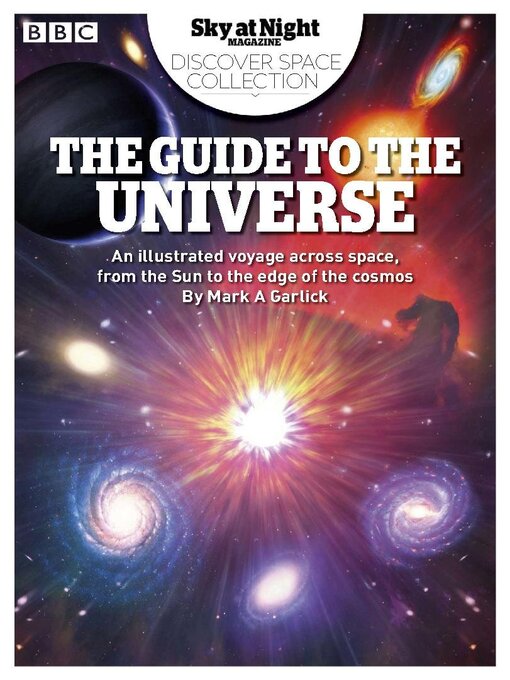The latest special edition from BBC Sky at Night Magazine, The Guide to The Universe takes you on a journey from the Solar System to the edge of space to encounter the familiar and exotic objects that make up the Universe. Beautifully illustrated throughout, with expert and clear-cut descriptions, it will give you a new perspective on our place in the vastness of space.
The Guide to the Universe
Welcome
PLANETS AND RELATED SPECIMENS
PLANETARY FORMATION • From gas and dust to planets, moons and a Sun. Where did all this stuff come from, and when?
GAS GIANTS • Massive, swirling and inhospitable: the hydrogen and helium worlds of Jupiter and Saturn
ICE GIANTS • Neptune and Uranus: cold, blue worlds on the icy outer reaches
TERRESTRIAL PLANETS • Earth and the three other rocky, solid worlds in our Solar System
ASTEROIDS • Carbon-rich, stony or metallic, millions of bodies in between Mars and Jupiter tell the tale of a violent past
DWARF PLANETS • Pluto and our other enigmatic mini worlds
SATELLITES & RINGS • Orbiting companions: the moons and fragments circling almost every planet
COMETS & COMET CLOUDS • ‘Dirty snowballs’ spewing long, dusty tails as they near the Sun
EXTRASOLAR PLANETS • Myriad worlds waiting to be discovered beyond our Solar System
THE STELLAR ZOO
PROTOSTARS: YOUNG STELLAR OBJECTS • Vast molecular clouds collapse and contract under gravity… and a star is born
T TAURI STARS: STELLAR ADOLESCENTS • The wind-whipped, electrically charged and unstable life of youthful stars
MAIN SEQUENCE STARS: NUCLEAR POWERHOUSES • We have ignition, as hydrogen fuses into helium
RED DWARFS: FEEBLE AND FAINT • The most common stars are faint, slow-burning and long-lasting
SUBGIANTS: GROWING OLD • The aging star begins consuming the hydrogen outside its shrunken core
GIANTS: GERIATRIC STARS • The bright, swollen fate awaiting our own Sun
SUPERGIANTS: LUMINOUS POWERHOUSES • Red or blue, these bright behemoths give new meaning to the word ‘big’
WHITE & BLACK DWARFS: STELLAR CORPSES • Its fuel exhausted, an inert, super-dense core is all that remains
NEUTRON STARS & PULSARS: THE ULTIMATE DENSITY • The small, incredibly dense end for massive stars
BLACK HOLES: LIGHT TRAPS • Infinitely dense, indefinitely collapsing stellar zombies
BROWN DWARFS: FAILED STARS • Too small to be stars, too large to be planets
CAMARADERIE OF THE STARS
WIDE BINARIES • Stellar pairs bound together but far apart, separate but in sync
NOVAE • When companion stars get too close their partnership ends in an incandescant explosion
DWARF NOVAE • They may lack the violence of their cousins but dwarf novae make up for it with frequency
INTERMEDIATE POLARS • A sufficently strong magnetic field spells curtains for an accretion disc
POLARS • When a white dwarf’s magnetic field gets really strong, that’s when a star system’s behaviour becomes truly strange
LOW-MASS X-RAY BINARIES • Swap a white dwarf for a black hole and the results are phenomenal
HIGH-MASS X-RAY BINARIES • When distances are too great for gravity to work, that’s when the stellar wind steps in
MICROQUASARS • Powerful jets of gas led to the discovery of the third type of X-ray binary
ALGOL SYSTEMS • The right angle and proximity leads to eclipses that are as regular as clockwork
Overcontact BINARIES • Two become one through distortion and absorption
Multiple SYSTEMS • Membership of star systems isn’t capped at two
OPEN CLUSTERS • On the far edges of the Milky Way stars are being born in...
